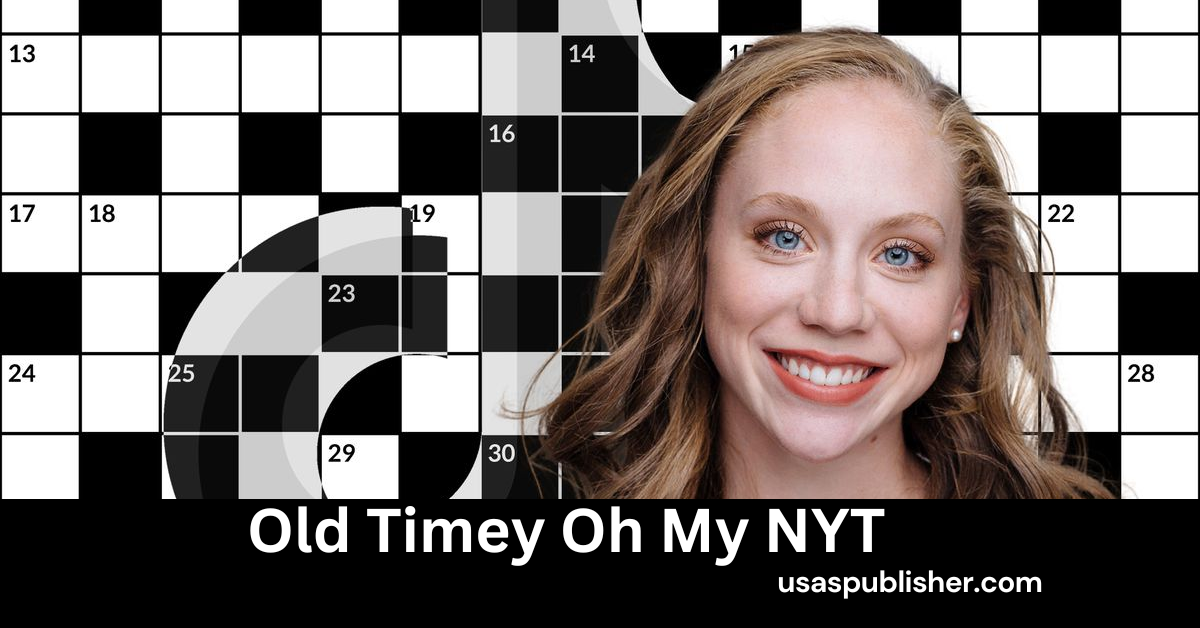Have you ever come across the phrase “old-timey oh my” while solving a New York Times crossword puzzle? This charming expression takes us on a nostalgic journey through the evolution of language and popular culture.
In this comprehensive article, we’ll explore the origins, usage, and cultural significance of this quaint exclamation that has found its way into the beloved NYT crossword.
The Origins of “Old-Timey Oh My”
The phrase “old-timey oh my” is a delightful combination of two elements: the adjective “old-timey” and the exclamation “oh my.” Let’s break it down:
- Old-Timey: This term refers to something that is reminiscent of or characteristic of a bygone era, typically the late 19th or early 20th century. It evokes a sense of nostalgia and charm associated with simpler times.
- Oh My: This exclamation has been used for centuries to express surprise, delight, or dismay. It’s a milder version of “oh my God” and has been a staple in English-speaking countries for generations.
When combined, “old-timey oh my” creates an image of a quaint, perhaps slightly dramatic expression of surprise that one might imagine hearing in a classic black-and-white film or reading in a vintage novel.
Also Read: Moszacos Lipstick Moisturizing – Hydration and Color in One
The New York Times Crossword Connection
The New York Times crossword puzzle, a daily brain-teaser enjoyed by millions, often includes clues that test solvers’ knowledge of language, history, and popular culture. The inclusion of “old-timey oh my” as a crossword clue speaks to its enduring place in our collective memory and its ability to evoke a specific time and feeling.
Crossword creators, known as constructors, cleverly use phrases like this to challenge solvers while also providing a touch of whimsy and nostalgia. The clue “Old-timey ‘Oh my!'” might lead solvers to answers such as “GOODNESS,” “GRACIOUS,” or “MERCY,” depending on the number of letters required and the surrounding puzzle context.
The Cultural Impact of Old-Timey Expressions
The popularity of phrases like “old-timey oh my” in modern contexts such as crossword puzzles reflects a broader cultural fascination with the language of the past. This interest manifests in several ways:
- Retro Revival: Many people find comfort and charm in adopting older expressions, seeing them as a way to connect with a perceived simpler time.
- Linguistic Preservation: Using these phrases helps keep them alive in our language, preserving a part of our cultural heritage.
- Generational Bridges: Younger generations may learn these expressions from grandparents or classic media, creating connections across age groups.
- Humor and Irony: Sometimes, using old-fashioned exclamations can add a touch of humor or irony to modern conversations.
Also Read: Slayunny2 – Revolutionizing Your Digital Experience
The Evolution of Exclamations
Exclamations like “oh my” have evolved over time, reflecting changes in society, culture, and language norms. Here’s a brief timeline of how such expressions have transformed:
- 17th-18th centuries: More formal exclamations like “Good heavens!” or “Upon my word!” were common.
- 19th century: “Oh my” gained popularity as a milder alternative to invoking deity names.
- Early 20th century: Variations like “Oh my stars!” or “Oh my goodness!” became fashionable.
- Mid-20th century: Shortened forms like “Gosh!” and “Golly!” emerged as even milder options.
- Late 20th-21st century: While many still use traditional exclamations, new expressions and acronyms (like “OMG”) have entered the lexicon.
Why “Old-Timey Oh My” Endures
Despite the constant evolution of language, phrases like “old-timey oh my” continue to resonate with people for several reasons:
- Nostalgia Factor: They remind us of a romanticized past, often associated with politeness and innocence.
- Family Connections: Many people remember hearing these expressions from older relatives, creating a sense of familial warmth.
- Media Influence: Classic films, TV shows, and literature keep these phrases alive in popular culture.
- Mild Nature: As a gentler exclamation, it’s suitable for all audiences and situations.
- Distinctive Sound: The rhythm and sound of “oh my” are pleasing to the ear and easy to say.
Old-Timey Expressions in Modern Media
While “old-timey oh my” might seem like a relic of the past, it and similar expressions continue to appear in various forms of modern media:
Also Read: https://multigrafico.com/khalil-chishtee-no-todo-el-arte-es-belleza
- Period Dramas: TV shows and movies set in earlier eras often feature characters using these expressions for authenticity.
- Retro-Inspired Content: Some contemporary works deliberately use older language to create a specific atmosphere or aesthetic.
- Children’s Media: Gentler exclamations are often preferred in content aimed at younger audiences.
- Comedy: Old-fashioned phrases can be used for comedic effect, especially when contrasted with modern situations.
The Linguistics of Exclamations
From a linguistic perspective, exclamations like “oh my” serve important functions in communication:
- Emotional Expression: They provide a quick way to convey surprise, shock, or other strong emotions.
- Conversation Fillers: These phrases can fill pauses in speech, giving the speaker time to think.
- Emphasis: Exclamations can add emphasis to statements or reactions.
- Social Bonding: Shared expressions can create a sense of community or shared culture among speakers.
Old Timey Oh My NYT: A Crossword Staple
The New York Times crossword puzzle, renowned for its clever clues and cultural references, frequently includes phrases like “old-timey oh my” for several reasons:
- Word Play: These phrases lend themselves well to puns and clever cluing.
- Knowledge Testing: They challenge solvers to recall older expressions and their contexts.
- Broad Appeal: Such clues can be solved by different generations, making the puzzle more inclusive.
- Cultural Education: Including these phrases exposes solvers to different aspects of language history.
The Future of Old-Timey Expressions
As language continues to evolve, what does the future hold for phrases like “old-timey oh my”?
- Digital Preservation: Online databases and digital archives will likely keep these expressions alive for future generations.
- Cyclical Revival: Language trends often cycle, so we may see periodic revivals of older expressions.
- Educational Value: These phrases may be taught as part of language history and cultural studies.
- Continued Media Use: As long as period pieces and nostalgic content remain popular, these expressions will have a place in media.
Also Read: /liveamoment.org – Discover Mindfulness and Connection
Conclusion
Old Timey Oh My NYT is more than just a charming phrase from the past or a tricky crossword clue. It represents a fascinating slice of linguistic history, cultural memory, and the enduring human need for expressive language. Whether encountered in a puzzle, heard in a classic film, or used ironically by a friend, this phrase continues to delight and intrigue language enthusiasts and casual speakers alike.
As we move forward in an ever-changing linguistic landscape, expressions like “old-timey oh my” serve as delightful reminders of where our language has been and how it continues to shape our communication and culture. So the next time you come across this phrase, whether in a crossword or conversation, take a moment to appreciate the rich history and enduring charm of these old-timey exclamations.
FAQs About “Old Timey Oh My NYT”
What does “old-timey oh my” mean?
“Old-timey oh my” refers to an outdated or vintage way of expressing surprise or amazement, similar to saying “oh my goodness” or “oh my stars” in a manner reminiscent of earlier times.
Why is “old-timey oh my” used in NYT crossword puzzles?
The New York Times crossword often includes this phrase as a clue because it tests solvers’ knowledge of older expressions and adds a touch of nostalgia and whimsy to the puzzle.
Are there other similar old-timey expressions?
Yes, there are many, such as “Heavens to Betsy,” “Goodness gracious,” and “Well, I’ll be!” These expressions serve similar functions in conveying surprise or emphasis in a quaint, old-fashioned way.
Is “old-timey oh my” still used in everyday speech?
While not as common as in the past, some people still use this expression, often for humorous effect or to add a touch of vintage charm to their speech.
How can I incorporate “old-timey oh my” into my vocabulary?
You can use it in place of more modern exclamations when you want to express surprise in a playful or nostalgic way. It’s particularly effective in lighthearted or ironic contexts.
What era is considered “old-timey” in this context?
Generally, “old-timey” refers to the late 19th and early 20th centuries, roughly from the 1880s to the 1930s.
How has the use of exclamations like “oh my” changed over time?
Exclamations have evolved from more formal expressions to shorter, less religious forms. Modern usage often includes acronyms and internet slang.
Are there regional variations of “old-timey oh my”?
Yes, different regions may have their own versions or variations of this expression, reflecting local dialects and cultural influences.
How does the NYT crossword clue for “old-timey oh my” usually appear?
It might appear as “Old-fashioned exclamation” or “Vintage expression of surprise,” with the answer being a word or phrase that fits the given number of letters.
Can using “old-timey oh my” make my speech sound outdated?
While it can add a vintage flair to your speech, using it occasionally or in appropriate contexts won’t necessarily make you sound outdated. It’s all about how and when you use it.





